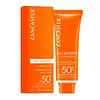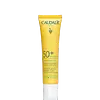What's inside
What's inside
 Key Ingredients
Key Ingredients

 Benefits
Benefits

 Concerns
Concerns

No concerns
 Ingredients Side-by-side
Ingredients Side-by-side

Water
Skin ConditioningDicaprylyl Carbonate
EmollientOctocrylene
UV AbsorberGlycerin
HumectantTribehenin PEG-20 Esters
EmollientButyl Methoxydibenzoylmethane
UV AbsorberC12-15 Alkyl Benzoate
AntimicrobialAlcohol
AntimicrobialEthylhexyl Methoxycinnamate
UV AbsorberMethylene Bis-Benzotriazolyl Tetramethylbutylphenol
UV FilterDiethylhexyl Butamido Triazone
UV AbsorberMethyl Methacrylate Crosspolymer
Nylon-12
Bis-Ethylhexyloxyphenol Methoxyphenyl Triazine
Skin ConditioningPotassium Cetyl Phosphate
EmulsifyingTitanium Dioxide
Cosmetic Colorant1,2-Hexanediol
Skin ConditioningAcrylates Copolymer
Alumina
AbrasiveAluminum Hydroxide
EmollientAluminum Stearate
Cosmetic ColorantAscorbic Acid
AntioxidantAscorbyl Palmitate
AntioxidantBHT
AntioxidantBisabolol
MaskingCalcium Sodium Phosphosilicate
Caprylyl Glycol
EmollientCitric Acid
BufferingDecyl Glucoside
CleansingDimethylmethoxy Chromanol
AntioxidantDisodium EDTA
Gluconolactone
Skin ConditioningGossypium Hirsutum Extract
Skin ConditioningHippophae Rhamnoides Oil
EmollientJasminum Officinale Flower Extract
MaskingLinoleic Acid
CleansingLinolenic Acid
CleansingMauritia Flexuosa Fruit Oil
Skin ConditioningMica
Cosmetic ColorantPanthenol
Skin ConditioningPantolactone
HumectantPEG-8
HumectantPentylene Glycol
Skin ConditioningPropylene Glycol
HumectantRuby Powder
Skin ConditioningSodium Hydroxide
BufferingStearic Acid
CleansingSucrose
HumectantTapioca Starch
Tocopherol
AntioxidantXanthan Gum
EmulsifyingXanthophylls
Skin ConditioningChlorphenesin
AntimicrobialPhenoxyethanol
PreservativeSodium Benzoate
MaskingParfum
MaskingCI 77891
Cosmetic ColorantWater, Dicaprylyl Carbonate, Octocrylene, Glycerin, Tribehenin PEG-20 Esters, Butyl Methoxydibenzoylmethane, C12-15 Alkyl Benzoate, Alcohol, Ethylhexyl Methoxycinnamate, Methylene Bis-Benzotriazolyl Tetramethylbutylphenol, Diethylhexyl Butamido Triazone, Methyl Methacrylate Crosspolymer, Nylon-12, Bis-Ethylhexyloxyphenol Methoxyphenyl Triazine, Potassium Cetyl Phosphate, Titanium Dioxide, 1,2-Hexanediol, Acrylates Copolymer, Alumina, Aluminum Hydroxide, Aluminum Stearate, Ascorbic Acid, Ascorbyl Palmitate, BHT, Bisabolol, Calcium Sodium Phosphosilicate, Caprylyl Glycol, Citric Acid, Decyl Glucoside, Dimethylmethoxy Chromanol, Disodium EDTA, Gluconolactone, Gossypium Hirsutum Extract, Hippophae Rhamnoides Oil, Jasminum Officinale Flower Extract, Linoleic Acid, Linolenic Acid, Mauritia Flexuosa Fruit Oil, Mica, Panthenol, Pantolactone, PEG-8, Pentylene Glycol, Propylene Glycol, Ruby Powder, Sodium Hydroxide, Stearic Acid, Sucrose, Tapioca Starch, Tocopherol, Xanthan Gum, Xanthophylls, Chlorphenesin, Phenoxyethanol, Sodium Benzoate, Parfum, CI 77891
Water
Skin ConditioningDibutyl Adipate
EmollientDiethylamino Hydroxybenzoyl Hexyl Benzoate
UV FilterPropanediol
SolventDicaprylyl Carbonate
EmollientEthylhexyl Triazone
UV AbsorberMethylpropanediol
SolventBis-Ethylhexyloxyphenol Methoxyphenyl Triazine
Skin ConditioningPhenylbenzimidazole Sulfonic Acid
UV AbsorberArginine
MaskingC20-22 Alkyl Phosphate
EmulsifyingC20-22 Alcohols
Emulsion StabilisingBenzotriazolyl Dodecyl P-Cresol
UV AbsorberPalmitoyl Grape Seed Extract
Skin ConditioningGlycerin
HumectantCaprylyl Glycol
EmollientCaprylyl/Capryl Glucoside
CleansingEthylhexylglycerin
Skin ConditioningPotassium Cetyl Phosphate
EmulsifyingXanthan Gum
EmulsifyingPhenylpropanol
MaskingO-Cymen-5-Ol
AntimicrobialSodium Benzoate
MaskingPolyacrylate Crosspolymer-6
Emulsion StabilisingTocopheryl Acetate
AntioxidantPicea Abies Wood Extract
Helianthus Annuus Seed Oil
EmollientTocopherol
AntioxidantWater, Dibutyl Adipate, Diethylamino Hydroxybenzoyl Hexyl Benzoate, Propanediol, Dicaprylyl Carbonate, Ethylhexyl Triazone, Methylpropanediol, Bis-Ethylhexyloxyphenol Methoxyphenyl Triazine, Phenylbenzimidazole Sulfonic Acid, Arginine, C20-22 Alkyl Phosphate, C20-22 Alcohols, Benzotriazolyl Dodecyl P-Cresol, Palmitoyl Grape Seed Extract, Glycerin, Caprylyl Glycol, Caprylyl/Capryl Glucoside, Ethylhexylglycerin, Potassium Cetyl Phosphate, Xanthan Gum, Phenylpropanol, O-Cymen-5-Ol, Sodium Benzoate, Polyacrylate Crosspolymer-6, Tocopheryl Acetate, Picea Abies Wood Extract, Helianthus Annuus Seed Oil, Tocopherol
 Reviews
Reviews

Ingredients Explained
These ingredients are found in both products.
Ingredients higher up in an ingredient list are typically present in a larger amount.
You might know this ingredient as Tinosorb S or Bemotrizinol. It is a UV filter that covers both UVA and UVB rays.
This ingredient has two peak UV absorption peaks ( 310 and 340 nm) and is able to absorb both UV-A and UV-B rays. This ingredient works by preventing UV rays from reaching and damaging your skin.
On top of that - it is highly photostable and helps prevent the photodegration of other sunscreen ingredients such as avobenzone.
Tinosorb S is allowed in the EU, Australia, and Asia. It is close to being approved by the FDA and we'll hopefully get this ingredient in the U.S. by late 2025.
Fun fact: Tinosorb S is the most effective UV absorber at maximum concentration (measured by SPF) permitted in the EU.
This ingredient is oil-soluble, so your oil-cleansers will take this right off at night.
Learn more about Bis-Ethylhexyloxyphenol Methoxyphenyl TriazineCaprylyl Glycol is a humectant and emollient, meaning it attracts and preserves moisture.
It is a common ingredient in many products, especially those designed to hydrate skin. The primary benefits are retaining moisture, skin softening, and promoting a healthy skin barrier.
Though Caprylyl Glycol is an alcohol derived from fatty acids, it is not the kind that can dry out skin.
This ingredient is also used as a preservative to extend the life of products. It has slight antimicrobial properties.
Learn more about Caprylyl GlycolDicaprylyl Carbonate comes from carbonic acid and caprylyl alcohol, a fatty alcohol. It is an emollient and gives skin a velvet feel. The sources of Dicaprylyl Carbonate may be synthetic or from animals.
As an emollient, Dicaprylyl Carbonate creates a film on the skin. This film traps moisture in, keeping your skin soft and hydrated.
Glycerin is already naturally found in your skin. It helps moisturize and protect your skin.
A study from 2016 found glycerin to be more effective as a humectant than AHAs and hyaluronic acid.
As a humectant, it helps the skin stay hydrated by pulling moisture to your skin. The low molecular weight of glycerin allows it to pull moisture into the deeper layers of your skin.
Hydrated skin improves your skin barrier; Your skin barrier helps protect against irritants and bacteria.
Glycerin has also been found to have antimicrobial and antiviral properties. Due to these properties, glycerin is often used in wound and burn treatments.
In cosmetics, glycerin is usually derived from plants such as soybean or palm. However, it can also be sourced from animals, such as tallow or animal fat.
This ingredient is organic, colorless, odorless, and non-toxic.
Glycerin is the name for this ingredient in American English. British English uses Glycerol/Glycerine.
Learn more about GlycerinPotassium Cetyl Phosphate is the potassium salt of a mixture. This mixture consists of the esters from phosphoricacid and cetyl alcohol.
Potassium Cetyl Phosphate is an emulsifier and cleansing agent. Emulsifiers help stabilize a product. It does this by preventing certain ingredients from separating.
As a cleansing agent, Potassium Cetyl Phosphate helps gather oils, dirts, and pollutants from your skin. This makes it easier to rinse them away with water.
Learn more about Potassium Cetyl PhosphateSodium Benzoate is a preservative. It's used in both cosmetic and food products to inhibit the growth of mold and bacteria. It is typically produced synthetically.
Both the US FDA and EU Health Committee have approved the use of sodium benzoate. In the US, levels of 0.1% (of the total product) are allowed.
Sodium benzoate works as a preservative by inhibiting the growth of bacteria inside of cells. It prevents the cell from fermenting a type of sugar using an enzyme called phosphofructokinase.
It is the salt of benzoic acid. Foods containing sodium benzoate include soda, salad dressings, condiments, fruit juices, wines, and snack foods.
Studies for using ascorbic acid and sodium benzoate in cosmetics are lacking, especially in skincare routines with multiple steps.
We always recommend speaking with a professional, such as a dermatologist, if you have any concerns.
Learn more about Sodium BenzoateTocopherol (also known as Vitamin E) is a common antioxidant used to help protect the skin from free-radicals and strengthen the skin barrier. It's also fat soluble - this means our skin is great at absorbing it.
Vitamin E also helps keep your natural skin lipids healthy. Your lipid skin barrier naturally consists of lipids, ceramides, and fatty acids. Vitamin E offers extra protection for your skin’s lipid barrier, keeping your skin healthy and nourished.
Another benefit is a bit of UV protection. Vitamin E helps reduce the damage caused by UVB rays. (It should not replace your sunscreen). Combining it with Vitamin C can decrease sunburned cells and hyperpigmentation after UV exposure.
You might have noticed Vitamin E + C often paired together. This is because it is great at stabilizing Vitamin C. Using the two together helps increase the effectiveness of both ingredients.
There are often claims that Vitamin E can reduce/prevent scarring, but these claims haven't been confirmed by scientific research.
Learn more about TocopherolWater. It's the most common cosmetic ingredient of all. You'll usually see it at the top of ingredient lists, meaning that it makes up the largest part of the product.
So why is it so popular? Water most often acts as a solvent - this means that it helps dissolve other ingredients into the formulation.
You'll also recognize water as that liquid we all need to stay alive. If you see this, drink a glass of water. Stay hydrated!
Learn more about WaterXanthan gum is used as a stabilizer and thickener within cosmetic products. It helps give products a sticky, thick feeling - preventing them from being too runny.
On the technical side of things, xanthan gum is a polysaccharide - a combination consisting of multiple sugar molecules bonded together.
Xanthan gum is a pretty common and great ingredient. It is a natural, non-toxic, non-irritating ingredient that is also commonly used in food products.
Learn more about Xanthan Gum